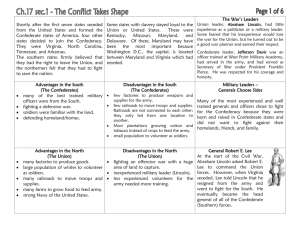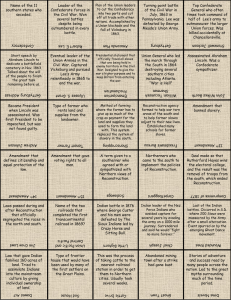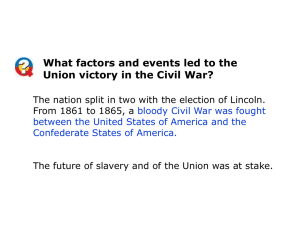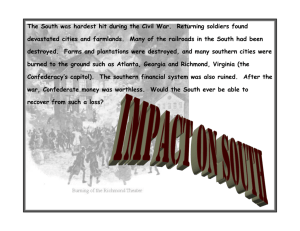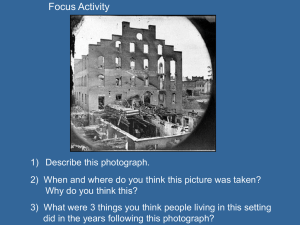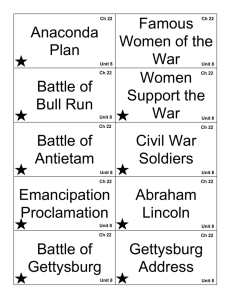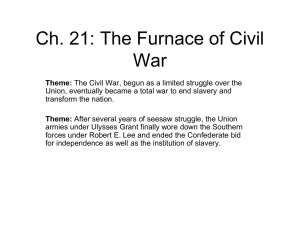File
advertisement
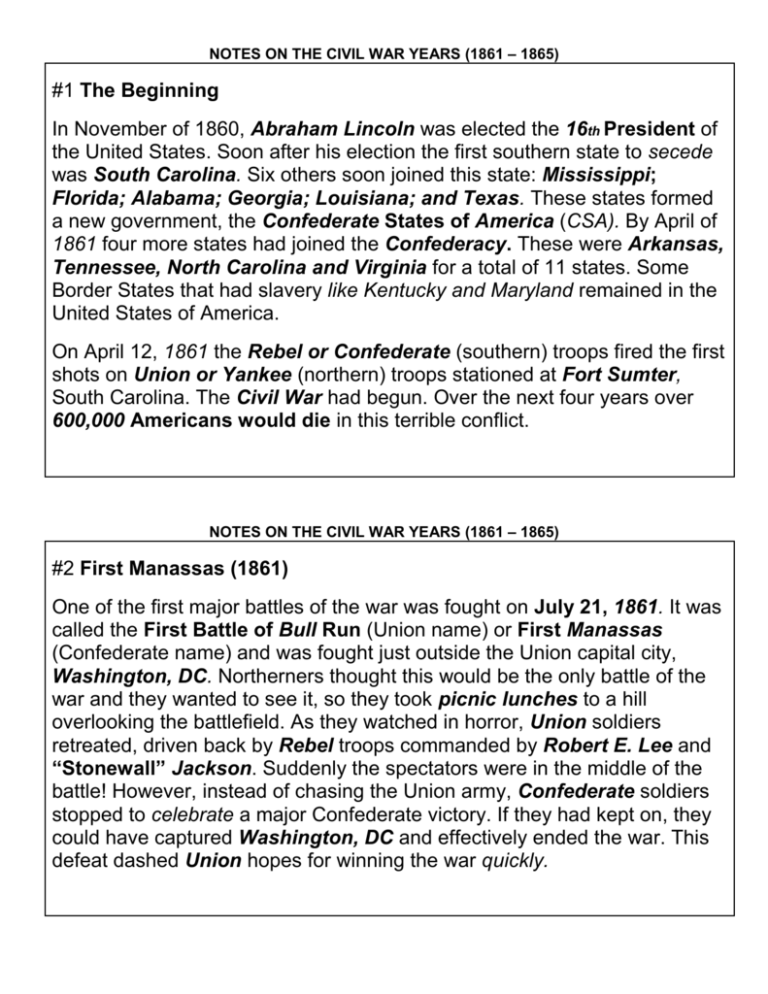
NOTES ON THE CIVIL WAR YEARS (1861 – 1865) #1 The Beginning In November of 1860, Abraham Lincoln was elected the 16th President of the United States. Soon after his election the first southern state to secede was South Carolina. Six others soon joined this state: Mississippi; Florida; Alabama; Georgia; Louisiana; and Texas. These states formed a new government, the Confederate States of America (CSA). By April of 1861 four more states had joined the Confederacy. These were Arkansas, Tennessee, North Carolina and Virginia for a total of 11 states. Some Border States that had slavery like Kentucky and Maryland remained in the United States of America. On April 12, 1861 the Rebel or Confederate (southern) troops fired the first shots on Union or Yankee (northern) troops stationed at Fort Sumter, South Carolina. The Civil War had begun. Over the next four years over 600,000 Americans would die in this terrible conflict. NOTES ON THE CIVIL WAR YEARS (1861 – 1865) #2 First Manassas (1861) One of the first major battles of the war was fought on July 21, 1861. It was called the First Battle of Bull Run (Union name) or First Manassas (Confederate name) and was fought just outside the Union capital city, Washington, DC. Northerners thought this would be the only battle of the war and they wanted to see it, so they took picnic lunches to a hill overlooking the battlefield. As they watched in horror, Union soldiers retreated, driven back by Rebel troops commanded by Robert E. Lee and “Stonewall” Jackson. Suddenly the spectators were in the middle of the battle! However, instead of chasing the Union army, Confederate soldiers stopped to celebrate a major Confederate victory. If they had kept on, they could have captured Washington, DC and effectively ended the war. This defeat dashed Union hopes for winning the war quickly. NOTES ON THE CIVIL WAR YEARS (1861 – 1865) #3 THE ANACONDA PLAN - UNION STRATEGY FOR WINNING The Union (USA) had a plan for winning the war, except parts of it didn’t work too well. The plan had four parts: 1) Blockade southern ports and cut off export trade of cotton and import trade of much needed manufactured goods and munitions to support the war; 2) get control of the Mississippi River and cut the Confederacy into two parts. This would also cut off important food and ammunition supplies being sent from Texas and Louisiana to the rest of the Confederacy; 3) capture the Confederate capital city, Richmond, Virginia and force the Confederate government to surrender; and 4) bring the Army of the West and the Union (Northern) Army of the Potomac together in a “squeeze” (like an Anaconda snake) and trap the Confederate army. Parts 1 and 2 of the plan worked fairly well (after two years) but it took the Union (North) the entire four years of the war to complete parts 3 and 4. NOTES ON THE CIVIL WAR YEARS (1861 – 1865) #4 BATTLE OF SHILOH (TENNESSEE) In April of 1861, Confederate soldiers near Shiloh Creek in Tennessee surprised Union General Ulysses S Grant. After two bloody days of fighting, Rebel (Confederate) soldiers retreated and Grant claimed victory, but at great cost. In two days of fighting, 25,000 men died (13,000 Union and 12,000 Rebels) One of those killed was General Albert Sydney Johnston a Texan and the 2nd highest ranking General (next to Lee) in the Confederate army. This was a great loss for Texas and the Confederacy. Even though General Grant won, some Northern politicians wanted him fired, but President Lincoln said, “I can’t spare this man, he fights!” THE BATTLE OF ANTIETAM (MARYLAND) On September 17, 1861 General Robert E. Lee attempted to win a victory in the North (one of only two major battles on Northern soil). His goal was to cut off Washington, DC , the capital, from the rest of the Union. Lee and Union armies met at Antietam, Maryland in the bloodiest one day battle of the war. Casualties for the N and S = 5,000 dead; 18,000 wounded. Neither side won but General Robert E. Lee was forced to retreat south to Virginia to protect his supply lines in the Shenendoah Valley. Early in 1863 , Lincoln issued the Emancipation Proclamation , a document to free the slaves. NOTES ON THE CIVIL WAR YEARS (1861 – 1865) #5 JULY 1863, THE TURNING POINT OF THE WAR VICKSBURG The city of Vicksburg, Mississippi was a major point in controlling the Mississippi River. The Union army controlled the River from Memphis to New Orleans except for Vicksburg. The Rebels were sending food and supplies from Texas and Louisiana through Vicksburg to the rest of the Confederacy. General Ulysses S Grant laid siege to the city early in the Spring of 1863. By May 22 the siege was in full force. The citizens of Vicksburg and the Confederate army refused to give up. Most of the citizens and the Rebel army were starving and were forced to eat rats. They melted down everything in the town (door hinges, nails, metal furniture, and so on) to make bullets and cannon fire. Finally, on July 2, 1863 the Rebel army surrendered and ended the siege. Part of the Anaconda Plan was finally complete. NOTES ON THE CIVIL WAR YEARS (1861 – 1865) #6 JULY 1863, THE TURNING POINT OF THE WAR GETTYSBURG At the same time that Vicksburg was “falling”, far away in the East, Confederate General Robert E. Lee led his troops into Pennsylvania to meet General Meade’s Union soldiers. The Confederates hoped to win a victory here to encourage England to join the fight on the side of the South. During three days of fighting - July 1 – 3, 1863, Northern troops turned back wave after wave of Rebel attacks. In one attack, General Lee ordered General Pickett ‘ s troops to charge the center of the Union lines. He believed the Union troops had been weakened by cannon fire, but he was wrong. During Pickett ‘ s “Charge”, Union troops shot down wave after wave of Rebel soldiers. The next day, Lee and the Rebel army began to withdraw but was trapped by flooded rivers. If Meade had pursued the retreating Confederate soldiers, the war could have ended there, but he didn’t. However, the Confederacy would never again launch an attack in Northern territory. During these three days of fighting, over 52,000 men were killed or seriously wounded. General Lee went North with about 75,000 soldiers and lost almost 1/3 of his army, including many of his best generals and lieutenants. July of 1863 was the “beginning of the end” for the Confederate States of America. After that time in early July, the Confederacy had no real hope of winning the war and yet they continued to fight through another one and one half years of bloody battles. NOTES ON THE CIVIL WAR YEARS (1861 – 1865) #7 GRANT TAKES COMMAND OF THE UNION ARMY OF THE POTOMAC After his victories in the West, President Abraham Lincoln named General Ulysses S Grant commander of the Union army in the East (1864). For the next year and onehalf, Grant fought hard against General Robert E. Lee and the Confederate Army of Northern Virginia. Most of this fighting was in the 90 miles that separated the two capital cities. The fighting was fierce, but the Rebels had no real hope of winning. They were running out of vital supplies (food, ammunition, medicine for the wounded, and so on). While Grant was pushing through Virginia, General Sherman was “marching through Georgia from Atlanta to the sea (Savannah). The major Southern city of Atlanta, Georgia fell in 1864 (the book/movie “Gone with the Wind” is about this time in history) but the Confederates continued to fight. In the Spring of 1865, Union General Grant captured the city of Petersburg, near Richmond after a year-long siege. Then Grant marched on the Confederate capital. In March of 1865, Richmond, Virginia was captured and burned. Lee and the remaining Confederate army retreated west heading for the mountains, trying to escape the Union army. Finally, on April 9, 1865 at a place in Virginia called Appomattox Courthouse, General Robert E. Lee surrendered his army to Union General Ulysses S. Grant. The Civil War was finally over . . . at least the fighting! NOTES ON THE CIVIL WAR YEARS (1861 – 1865) #8 THE WAR IN TEXAS Texas was not the scene of many Civil War battles. One battle in 1862 was in Galveston and Confederate troops defeated a Union ship to keep the Blockade open in Galveston harbor. Another battle, the Battle of Sabine Pass was also about controlling waterways. However, Texas did contribute much to the war effort. Of the 92,000 white males between the ages of 18 and 65 in Texas, 60,000 of these fought at some time in the Confederate army! Of those 60,000 men, almost 1/3 (20,000) were killed and/or wounded severely. Many Texans, like Hood’s Texas Brigade and Terry’s Texas Rangers fought with Robert E. Lee in Virginia. Terry’s Texas Rangers, a cavalry unit lost over 2/3 of its men in the four years of fighting! Texas also provided food supplies (especially beef and corn), some munitions, and other supplies. Texans also sent gold and other money to the Confederacy. Not all Texans supported the South. Texans who supported the North were called Unionists. Over 2,000 of these men joined the Union army, including 50 free Blacks. The last “battle” of the Civil War was fought at Palmito Ranch on May 12, 1865 – One month after Lee surrendered at Appomattox.
